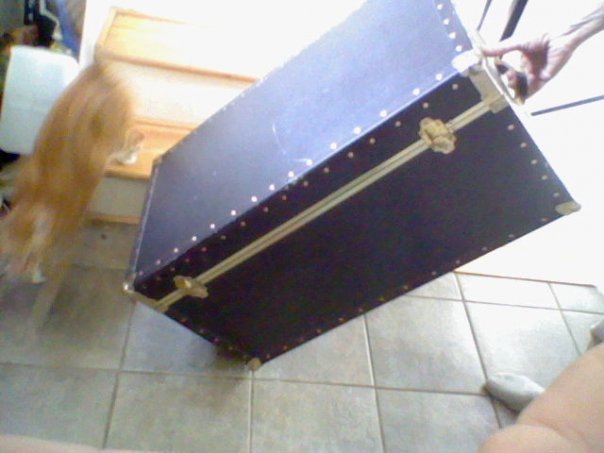
Yes, it's a rolling trunk, and I'll admit it's not the most exciting science prop. But there are four important details that make this an important detail in DIY satellite building.
1) Pragmatics. I need a place to store the satellite and components when I'm not working on it.
2) Conveyance. I need something to lug the kit around when I take it over to my friend's workshop, when we eventually get to final assembly.
3) Promotion. I need to be able to lug the satellite (or flight spare) to classrooms when I talk to K12 students about cool rocket science. The wheels are a crucial help here.
4) Cats. Notice the blur of the fast-moving cat to the left of the rolling trunk? Yes, we have a cat infestation problem in our house.
Back at Naval Research Lab, we have cats-- strays that roamed the garages and underbrush around the facility. But we never had cats indoors, and certainly did not have cats in our assembly rooms and labs.
But being stuck with a home lab means I must somehow ensure the cats don't mess up the satellite. I've declared our cat-free guest room as my lab, so I'm not worried about cats knocking stuff down or-- worse-- rewriting then recompiling the sensors code. No, my worry is fur.
I want this to be the first musical satellite, not the first fur-covered non-functioning cat satellite. This means I have to set up a clean room. A clean room in rocket parlance is exactly what it sounds like-- a very clean room. Typically, this means taking a room that is spic-and-span, and creating positive pressure. You make sure that clean air is being pumped into the room, and rely on the fact that the air has to leave as your way of keeping dust out.
A common setup is to run powerful intake fans that are well filtered, so they pump and filter lots of outside air in. You surround it with plastic curtains, so the air can escape, and rely on the mild wind (for want of a better term) to ensure no outside dust enters.

For bonus points, you can make the scientists wear bunny suits-- that's the actual name of the white cleanroom outfits. There are varying degrees of clean room standards. The clean room pictured above comes from the "DIY Clean Room" instructions at the fine 'instructables.com' site. For our work, we aren't doing fine optics or detectors with a high contamination risk, so we need only a moderate system.
Over at Make, they have something more my speed-- a homemade clean, err... clean box. It's really more my speed.

It's just what it looks like-- a plastic tub covered in transparent plastic, with little rubber gloves inside that you access from holes on the outside. But even that may be overkill for our pico-satellite, because, again, we have no optics, sensitive electronics, or other easily contaminated items.
In previous NASA missions, I've seen flight hardware sitting in the middle of dusty labs. Most hardware is fine that way, because most of it is a big hunk of metal. The only time for clean rooms is final assembly, when you put in the sensitive optics. You do vacuum tests later, and outgassing usually removes most contaminants. Vibration testing, likewise. Wrap it up and you're done.
Cleanliness is a progression, not an absolute from square one. So first I'll just be in a clean, cat-free room. Later, I'll use the trunk to transport to the metal shop. Then back to the lab. I'll be building a vacuum chamber and vibration rig for testing. After that, will transfer it to a sealed bag for final shipment. Our result will be a clean, but not ultra-clean, functional satellite.
But I may still wear a bunny suit. They just look so science-y!

Alex
Track The Satellite Diaries via RSS feed and Twitter @skyday (or go slumming in my main column, the Daytime Astronomer)




Comments